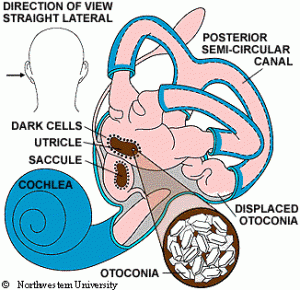Benign Paroxysmal Positional Vertigo, better known as BPPV, is the most common cause of dizziness over the age of 65, but can occur at any age. The most common symptom is usually spinning dizziness (vertigo) with positional changes, such as rolling over in bed, sitting up, lying down, bending over, or looking up. People with BPPV will feel that the room spins when they perform those positional changes. Symptoms of dizziness generally last less than 30 seconds, but imbalance tends to be constant throughout the day. What is the mechanism of this problem?
The vestibular system sits behind the inner ear and is made up of 2 otolith organs (the saccule and the utricle) and 3 semicircular canals (anterior, posterior, and horizontal) that are filled with fluid. This fluid moves in the canals as the head moves, sending a message to the brain to let it know how far, how fast, and in what direction the head has moved. This system is important for balance by providing head position information and stabilization of the eye muscles to allow vision to take in information properly. Located inside the utricle is a sticky membrane that holds a “pile” of calcium carbonate crystals, known as otoconia. When these “crystals” come out of position and fall into one of the canals, BPPV occurs.

The otoconia are dense and heavy. The pull of gravity on the otoconia are what cause them to move inside the utricle in a normal situation, which sends information to the brain about head motion. When they are out of place, and the head moves relative to gravity, the crystals move within the canal. This causes the fluid to move at an abnormal rate, sending an abnormal signal to the brain. The head may stop it’s motion, but the brain thinks the head is still moving due to the otoconia still moving inside the canal. This also causes an inability of the system to stabilize the eyes and rapid movement occurs, called nystagmus. This is why it appears the room is spinning. Once the otoconia stop moving, the system stops until another movement occurs again. Because of the displacement of the crystals, the system is “off” and creates a sense of imbalance in the person.
What can be done if this occurs? How is this treated?
Treatment is done through a technique called the canalith repositioning maneuver. This is a series of head movements to “roll” the crystals through the canal and allow them to drop out and return to their original location, the utricle. Many times this can be achieved in as little as one treatment, but may require more depending on how each individual system responds. Imbalance may continue to be a problem for several weeks after treatment.
A skilled Physical Therapist trained in vestibular rehabilitation can treat BPPV. While there is plenty of information on the internet, it is important to know the canal that is involved to treat the problem properly. Most sites will describe one form of treatment, but there are actually many different treatments. Improper treatment can make the problem worse by moving the crystals into additional canals. The side involved, the canal involved, and whether the crystals are free moving or attached, all determine which treatment is appropriate and that can be done by a Physical Therapist that specializes in vestibular rehabilitation.
Don’t let an easily treatable problem go untreated! You’ll feel better in a short matter of time and back to yourself.
